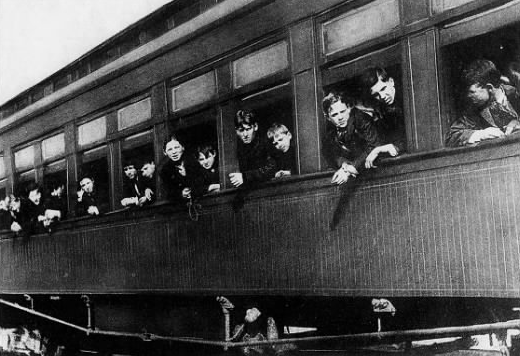Post navigation
Orphan Trains Head West
In 1853 Charles Loring Brace formed the Children’s Aid Society to develop programs for the growing population of orphaned children in New York City. In the mid-1800s, a wave of immigration brought newcomers to America. Without an extended family to fall back on, immigrants often crowded into unsanitary living conditions where illness spread creating high mortality rates. Other factors that contributed to the orphan population were disease, unsafe working conditions, poverty, and the Civil War. At one point an estimated 30,000 orphans roamed the streets of New York City. The Children’s Aid Society aimed to change that. From 1854 to 1929 an estimated 250,000 children were loaded onto Orphan Trainsand transported from eastern cities to the rural Midwest hoping to find adoptive homes. At the time, there was no federal government program to oversee child welfare.

For some, the Orphan Trains resulted in children being placed in loving, adoptive homes. Others were paraded before prospective adoptive families and treated like indentured servants.
Little 3-year-old Louise Anderson rode the Orphan Train and got adopted by a family whose daughter had died. She remembered her adoptive mother commenting, “We lost a little girl; she was so smart, and this one was a dummy.” Louise’s adoptive home was not a happy one. By the age of 12, she spent nights alone outside minding the cattle. She never attended school and was illiterate as a child. She married at 17 and learned to read and write alongside her young children.

Alice Ayler was one of the last to ride the Orphan Train in 1929. She was living in a tent in the Catskill Mountains in upstate New York with very little to eat. Her mother would often disappear for days at a time and eventually signed papers relinquishing her to the Children’s Aid Society. Ayler took the Orphan Train to Kansas and was adopted. “I was one of the luckier ones because I know my heritage,” Ayler said. “They took away the identity of the younger riders by not allowing contact with the past.”
Most children sent west on Orphan Trains retained few memories and no documentationabout their birth families. Siblings were often separated and never saw each other again. Seven-year-old Clara was an exception. Her parents and a sister died while trying to cross a river in New York state. She and her two younger brothers boarded an Orphan Train to Kansas where they were adopted by three different loving families. They remained in contact with one another throughout their lives.

Nettie Enns remembers boarding the Orphan train with her twin sister Nellie. They were given blankets, name tags and sack lunches for the four-day journey to Kansas. After arriving, the sisters were adopted but their first home was abusive. Nettie remembers her sister being hit with a horsewhip after falling and breaking a dish. The girls were eventually removed from the home and taken in by a woman they considered their mother, though she never officially adopted the girls. Later in lifeNettie and Nellie both married and lived across the street from each other.
Discovering information about family members who rode Orphan Trains is difficult, but sometimes possible. Begin with newspaper clippings in the city where they were adopted and branch outwards. Head over to Newspapers.com to learn more about Orphan Trains today!


